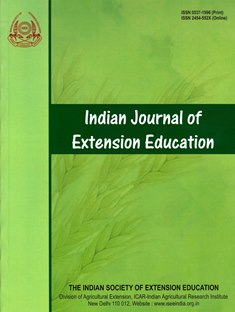Millet Adoption in Bundelkhand, U.P.: Traditional vs. Emerging Crop Trends
DOI:
https://doi.org/10.48165/IJEE.2025.613RN06Keywords:
Millet adoption, Traditional crops, Climate resilience, Nutritional security, BundelkhandAbstract
The study, conducted between January and March 2023, investigated millet adoption patterns among 400 farmers in Bundelkhand, Uttar Pradesh, India, comparing traditional crop cultivation with emerging millet trends in Jalaun and Jhansi districts. The current study’s findings indicated that millets, driven by climate resilience (50%), market demand (37.5%), and nutritional value (12.5%), are cultivated by 37.5 per cent of farmers, while traditional crops (wheat, rice, maize) dominate (62.5%) due to market reliability. Millets are consumed daily by 10 per cent, primarily at breakfast (30%) and lunch (25%), enhancing nutritional security. Significant challenges to millet adoption include limited market access and awareness. ANOVA and Chi-square tests revealed significant differences in crop selection and consumption across gender (p<0.01), age (p<0.05), and income (p<0.05). However, adoption requires robust policy support, with significant positive correlations for climate resilience (p=0.03) and nutritional benefits (p=0.04), while market access constraints (p=0.02) showed negative correlations. Composite reliability values, ranging from 0.750 to 0.980, demonstrated strong internal consistency across measured constructs.
Downloads
References
Abebe, T., Belay, G., Tadesse, T., & Keneni, G. (2020). Selection efficiency of yield-based drought tolerance indices in sorghum. African Journal of Agricultural Research, 15(3), 379–392.
Anbukkani, P., Balaji, S. J., Nithyashree, M. L., & Prakash (2017). Production and consumption of minor millets in India- A structural break analysis. Annals of Agricultural Research, New Series, 38(4), 438-445.
Banu, A., Ganapathy, M. S., Girish, M. R., Shankara, M. H., Begum, S. S., Gowda, V. G., & Kumar, T. L. (2022). Consumer preferences for minor millets in Tumakuru District, Karnataka, India. International Journal of Environment and Climate Change, 12(11), 2214–2220.
Garg, K. K., Singh, R., Anantha, K. H., Singh, A. K., Akuraju, V. R., Barron, J., Dev, I., Tewari, R. K., Wani, S. P., Dhyani, S. K., & Dixit, S. (2020). Building climate resilience in degraded agricultural landscapes through water management: A case study of Bundelkhand region, Central India. Journal of Hydrology, 591, 125592.
Hariprasanna, K. (2023). Small millets in India: Current scenario and way forward. Indian Farming, 73(1), 38–41.
Khadatkar, A., Dubey, U. C., Saini, N., & Ramadas, S. (2024). Assessment of nutritional status and dietary intake of Indian farm women. Nutrition, 118, 112262.
Kumar, A., Ojha, P. K., Mishra, D., Mishra, B. P., Kalia, A., Shukla, G., & Singh, G. (2025). Assessing knowledge and adoption of millets cultivation practices in the Bundelkhand region, India: A study of farmer perspectives. Journal of Experimental Agriculture International, 47(6), 471–476.
Kumar, A., Ojha, P. K., Mishra, D., Mishra, B. P., Kalia, A., Shukla, G., Verma, A. P., Gupta, B. K., Ojha, P., & Singh, G. (2025). Constraints faced by farmers in adopting recommended practices for millet cultivation in the Bundelkhand region, Uttar Pradesh. International Journal of Agricultural Extension and Social Development, 8(6), 99–101.
Kumar, R., Singh, A., & Kumar, M. (2023). Water-efficient millet based cropping systems for sustainable agriculture in semi-arid regions of India. Agricultural Water Management, 275, 108012.
Michaelraj, P. S. J., & Shanmugam, A. (2013). A study on millet-based cultivation and consumption in India. International Journal of Marketing, Financial Services & Management Research, 2(4), 49–58.
Mishra, K., Yenagi, N. B., & Hiremath, U. (2019). Effect of nutrition education intervention to diabetic subjects on use of millet recipes in the management of diabetes. Indian Journal of Extension Education, 55(4), 101–106.
Mohod, N. B., Borah, A., Goswami, P., et al. (2023). International Year of Millet 2023: A global initiative for sustainable food security and nutrition. International Journal of Plant & Soil Science, 35(19), 1204–1211.
Nyam, K. L., Tan, C. P., Lai, O. M., Long, K., & Man, Y. C. (2009). Physicochemical properties and bioactive compounds of selected seed oils. LWT-Food Science and Technology, 42(8), 1396–1403.
Padulosi, S., Mal, B., King, O. I., & Gotor, E. (2015). Minor millets as a central element for sustainably enhanced incomes, empowerment, and nutrition in rural India. Sustainability, 7(7), 8904–8933.
Rao, P. P., Birthal, P. S., Reddy, B. V., Rai, K. N., & Ramesh, S. (2006). Diagnostics of sorghum and pearl millet grains-based nutrition in India. International Sorghum and Millets Newsletter, 47, 93–96.
Sah, U., Dixit, G. P., Kumar, H., Ojha, J., Katiyar, M., Singh, V., & Singh, N. P. (2021). Performance of millets in Bundelkhand region of UP State. Indian Journal of Extension Education, 57(4), 120–125.
Tripathi, G., Jitendrakumar, P. H., Borah, A., Nath, D., Das, H., Bansal, S., Singh, N., & Singh, B. V. (2023). A review on nutritional and health benefits of millets. International Journal of Plant & Soil Science, 35(19), 1736–1743.
Books and Book Chapters:
Das, I. K., & Rakshit, S. (2016). Millets, their importance, and production constraints. In Biotic Stress Resistance in Millets (pp. 3–19). Academic Press.
Taylor, J. R., & Emmambux, M. N. (2008). Gluten-free cereal products and beverages. In Gluten-Free Foods and Beverages from Millets (pp. 119–148). Academic Press.
Working Papers and Reports:
Ayieko, M., & Tschirley, D. (2006). Enhancing access and utilization of quality seed for improved food security in Kenya. International Food Policy Research Institute Working Paper, 12, 1–25.
Downloads
Published
Issue
Section
License

This work is licensed under a Creative Commons Attribution-NonCommercial-NoDerivatives 4.0 International License.

